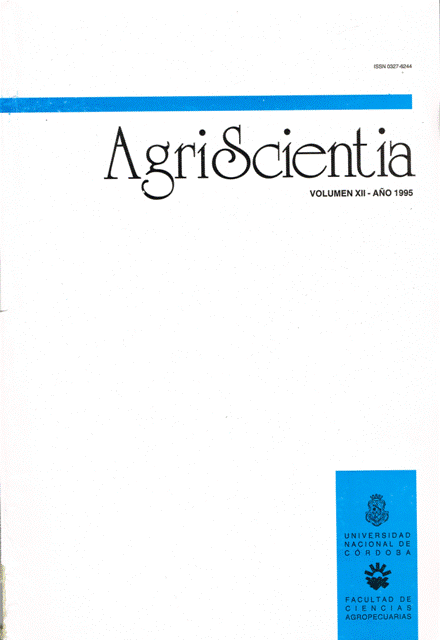Radical exudates of alfalfa (Medicago sativa L.) under salt stress conditions. Expression of nod genes in Rhizobium
Main Article Content
Abstract
A stress condition such as salinity may interfere with the transcription of nodulation (nod) genes in Rhizobium by modifying the composition of root exudates or the response of rhizobia. Root exudates of alfalfa (Medicago sativa L.) grown in 0.5% NaCl were collected over 6 days and analyzed by thin-layer chromatography (TLC). The induction of transcription of rhizobia nod genes was performed using an expression vector with the nod-lacZ fusion. The results indicate that the exudate patterns of treated plants differ from the controls over time, and that this delay induced by salt concentration does not affect the induction capacity of nod genes.
Article Details

This work is licensed under a Creative Commons Attribution-ShareAlike 4.0 International License.
How to Cite
References
Al-Rashidi, R.K., T.E. Loynachan, & L.R. Frederick. (1982). Desiccation tolerance of four strains of Rhizobium japonicum. Soil Biology and Biochemistry, 14, 489–493.
Andrés, J.A. (1994). Informe final Beca Formación 2º Nivel del Consejo de Investigaciones Científicas y Tecnológicas de la Provincia de Córdoba (CONICOR).
Aurag, J., & A. Sasson. (1992). Tolerance of Rhizobium leguminosarum by phaseoli to acidity and drought. World Journal of Microbiology and Biotechnology, 8, 532–533.
Chen, H., A.E. Richardson, & B.G. Rolfe. (1993). Studies of the physiological and genetic basis of acid tolerance in Rhizobium leguminosarum by trifolii. Applied and Environmental Microbiology, 59, 1798–1804.
CIAT. (1988). Manual de Métodos de Evaluación, Selección y Manejo FBN. Proyecto Especial CIAT, Centro Internacional de Agricultura Tropical, Cap. 9, pp. 5. Colombia.
Gaetano-Anollés, G., D.K. Christ-Estes, & W.D. Bauer. (1988). Chemotaxis of Rhizobium meliloti to the plant flavone luteolin requires functional nodulation genes. Journal of Bacteriology, 170, 3164–3169.
Graham, P.H., G. Ocampo, L.D. Ruiz, & A. Duque. (1980). Survival of Rhizobium phaseoli in contact with chemical seed protectants. Agronomy Journal, 72, 625–627.
Hartwig, U.A., C.A. Maxwell, C.M. Joseph, & D.A. Phillips. (1989). Interaction among flavonoid nod gene inducers released from alfalfa seeds and roots. Plant Physiology, 91, 1138–1142.
Hartwig, U.A., C.A. Maxwell, C.M. Joseph, & D.A. Phillips. (1990). Chrysoeriol and luteolin released from alfalfa seeds induce nod genes in Rhizobium meliloti. Plant Physiology, 92, 116–122.
Hartwig, U.A., C.M. Joseph, & D.A. Phillips. (1991). Flavonoids released naturally from alfalfa seeds enhance growth rate of Rhizobium meliloti. Plant Physiology, 95, 797–803.
Howieson, J.G., A.D. Robson, & L.K. Abbott. (1992). Acid-tolerant species of Medicago produce root exudates at low pH which induce the expression of nodulation genes in Rhizobium meliloti. Australian Journal of Plant Physiology, 19, 287–296.
Hungria, M.A., C.M. Joseph, & D.A. Phillips. (1991). Anthocyanidins and flavonols, major nod gene inducers from a black-seeded common bean (Phaseolus vulgaris L.). Plant Physiology, 97, 751–758.
Kosslak, R.M., R. Bookland, J. Barkei, H.E. Paaren, & E.R. Appelbaum. (1987). Induction of Bradyrhizobium japonicum common nod genes by isoflavones from Glycine max. Proceedings of the National Academy of Sciences USA, 84, 7428–7432.
Marenco, R.A., N. Fernandes Lopes, & P.K. Mosquim. (1993). Nodulation and nitrogen fixation in soybeans treated with herbicides. Revista Brasileira de Fisiologia Vegetal, 5, 121–126.
Martensson, A.M. (1992). Effects of agrochemicals and heavy metals on fast-growing rhizobia and their symbiosis with small-seeded legumes. Soil Biology and Biochemistry, 24, 435–445.
Maxwell, C.A., U.A. Hartwig, C.M. Joseph, & D.A. Phillips. (1989). A chalcone and two related flavonoids released from alfalfa roots induce nod genes of Rhizobium meliloti. Plant Physiology, 91, 842–847.
Maxwell, C.A., & D.A. Phillips. (1990). Concurrent synthesis and release of nod-gene-inducing flavonoids from alfalfa roots. Plant Physiology, 93, 1552–1558.
Michiels, J., C. Verreth, & J. Vanderleyden. (1994). Effects of temperature stress on bean-nodulating Rhizobium strains. Applied and Environmental Microbiology, 60, 1206–1212.
Miller, J. (1972). Experiments in Molecular Genetics. Cold Spring Harbor Laboratory Press: Cold Spring Harbor, N.Y., pp. 352–355.
Mohammad, R.M., M. Akhavan-Kharazian, W.F. Campbell, & M.D. Rumbaugh. (1991). Identification of salt- and drought-tolerant Rhizobium meliloti strains. Plant and Soil, 134, 271–276.
Peters, N.K., J.W. Frost, & S.R. Long. (1986). A plant flavone, luteolin, induces expression of Rhizobium meliloti nodulation genes. Science, 233, 977–980.
Peters, N.K., & S.R. Long. (1988). Alfalfa root exudates and compounds that promote or inhibit induction of Rhizobium meliloti nodulation genes. Plant Physiology, 88, 396–400.
Phillips, D.A., & S.M. Tsai. (1992). Flavonoids as plant signals to rhizosphere microbes. Mycorrhiza, 1, 55–58.
Redmond, J.W., M. Batley, M.A. Djordjevic, R.W. Innes, P.L. Kuempel, & B.G. Rolfe. (1986). Flavones induce expression of nodulation genes in Rhizobium. Nature, 323, 632–634.
Rennie, R.J., & S. Dubetz. (1984). Effect of fungicides and herbicides on nodulation and N₂ fixation in soybean fields lacking indigenous Rhizobium japonicum. Agronomy Journal, 76, 451–454.
Revellin, C., P. Leterme, & G. Catroux. (1993). Effect of some fungicide seed treatments on the survival of Bradyrhizobium japonicum and on the nodulation and yield of soybean (Glycine max L. Merr.). Biology and Fertility of Soils, 16, 211–214.
Vincent, J.M. (1975). Manual Práctico de Rhizobiología. Editorial Hemisferio Sur, Buenos Aires, Argentina, Cap. 1, pp. 4–5.
Yueh, L.Y., & D.L. Hensley. (1993). Pesticide effect on acetylene reduction and nodulation by soybean and lima bean. Journal of the American Society for Horticultural Science, 118, 73–76.
Zaat, S.A.J., C.A. Wijffelman, H.P. Spaink, A.A.N. Van Brussel, R.J. Okker, & B.J.J. Lugtenberg. (1987). Induction of the nodA promoter of Rhizobium leguminosarum sym plasmid pRL1JI by plant flavones. Journal of Bacteriology, 169, 198–204.
Zaat, S.A.J., C.A. Wijffelman, I.H.M. Mulders, A.A.N. Van Brussel, & B.J.J. Lugtenberg. (1988). Root exudates of various host plants of Rhizobium leguminosarum contain different sets of inducers of Rhizobium nodulation genes. Plant Physiology, 86, 1298–1303.





